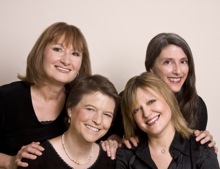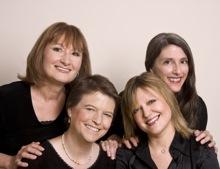No, putting together a concert program of folk music and polyphony from the Middle Ages, and later, requires active research and thought, and few people are as accomplished at those things as Susan Hellauer, Anonymous 4’s unofficial medieval music librarian, program annotator, and chief poker-around-in-dark-corners. Over the years, Hellauer and her friends have illuminated aspects of medieval life and ritual, including three programs of Christmas music, On Yoolis Night (1993), Legends of Saint Nicholas (1996), and Wolcum Yule (2003).

On this last CD, the group sang a number, The Cherry Tree Carol, that became the basis of their latest program of seasonal music, which they premiered in 2008, and which they bring to their San Francisco Performances concert on Dec. 3. In the meantime, however, the group had released two CDs of Anglo-African spiritual music (Marsha Genensky’s main area of research), embracing hymns, revival songs, and spiritual as well as gospel numbers. This latest program bridges the two worlds in a concert that will show as many continuities as fault lines.
“When American composers started to write in parts, they tended to use open fifths and octaves,” just as medieval musicians did, Genensky said. “When I was younger and heard shape-note singing, it sounded like medieval music to me.” (See here for more.)
The Cherry Tree Carol and another medieval carol, Marvel Not, Joseph, tell the story of Jesus’ earthly father who, by the intervention of an angel, comes to understand that Mary’s child was conceived by a miracle. Anonymous 4 then weave a set of medieval carols and add a second set of American songs ranging from shape-note tunes taken from a 19th-century hymnbook, The Southern Harmony, to William Billings’ fuguing tune Bethlehem, to a 1813 carol calledA Virgin Unspotted.
Of course, most of us who attend this concert will have gone to be refreshed and inspired by the group’s vocal purity and the energetic, earthy beauty of the music. Yet there’s something about the winter-solstice season that always draws us back to lost (or almost lost) folk traditions, something that makes us want to carol or take up crafts, or decorate our houses with symbolic plants and iconography, even if we’re not religious. Genensky remarked in an NPR interview that Anonymous 4’s audience often embraces a variety of agnostics and what she calls “seekers.” She relates her conversation with a young man who told her: “I used to be a Dead-head. Now I'm a ‘4’-head.” And this seems to be the season for seeking.
Those of us who love music have always known that when we participate in carols, whether singing them at church, serenading neighbors with them on winter lawns, or listening to them in a concert setting, we are making an important connection with folk traditions that go back centuries. In combining these two related but divergent musical repertories, Anonymous 4 opens us a fresh window into our medieval inheritance and the history that goes with it.

